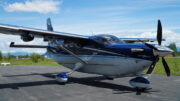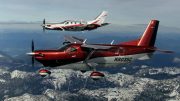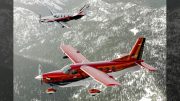Sandpoint, Idaho, USA, June 1, 2021 – Daher’s Kodiak 100 will improve and expand fixed- wing emergency medical services through their use in the U.S. as air ambulances by Airborne Flying Service, Inc., beginning with two aircraft leased from the non-profit American Heritage organization for operations in the South Central U.S. region.
For 25 years, Airborne Flying Service has operated as an air charter company based in Hot Springs, Arkansas with an air medical operations location in Little Rock, Arkansas since 2016. The first of these Kodiak 100s is supporting the ground and airborne network of LifeNet Emergency Medical Services, with Airborne Flying Service taking advantage of the airplane’s STOL (short take-off and landing) characteristics in extending operations to more airports near rural communities.
JB Kirk, Airborne Flying Service’s president, said the benefits of the Kodiak 100 in an air ambulance role include the aircraft’s operational cost effectiveness, its large loading door, an airframe that is lower to the ground, and the state-of-the art cockpit with integrated flight deck.
“The Kodiak 100 was a very deliberate choice after considering a full range of options, having made detailed analyses on capabilities and costs for new and used aircraft in single- and twin-engine versions,” Kirk explained. “Safety is the most important element of every flight we perform, and the Kodiak 100 fully meets our needs – especially at night and in bad weather – because it is simple and easy to use. Additionally, the PT6A-34 engine is a ‘bulletproof’ powerplant based on its proven reliability.”
In launching operations with the Kodiak 100, Airborne Flying Service is making the aircraft interoperable with ground ambulances through its development of a roll-on/roll-off capability. This avoids the necessity of moving a patient on/off a stretcher during transfers, while reducing the time a patient is exposed during loading/unloading between the ambulance and aircraft. It also facilitates the handling of heavier-weight patients. Transporting bariatric patients in the past has been challenging for the air medical transport industry because of smaller doors and less capable equipment.
“The airplane’s ergonomics are exactly what we need for emergency services,” Kirk said. “While its cross-section and payload are very similar to our twin-engine aircraft, the Kodiak 100’s acquisition and operating costs are much more attractive than a twin, and its lower landing speed opens many more runways for our services.”
Nicolas Chabbert, the Senior Vice President of Daher’s Aircraft Division and CEO of Kodiak Aircraft, said the Kodiak 100 is perfectly suited for emergency medical airlift to underserved markets, enabling flights directly to local airports.
“Airborne Flying Service has developed a very promising scenario for the Kodiak 100 in air ambulance applications,” Chabbert added. “The company’s experience working with multiple ambulance services and building transport networks in underserved areas makes this a great opportunity. We are fully ready to support its development of such operations and to seek future evolution for the aircraft in other markets.”
The two Kodiak 100s acquired by the American Heritage organization and leased to Airborne Flying Service were sold by American Kodiak, the authorized Kodiak 100 dealership that covers the seven U.S. central states from Texas, Louisiana and Arkansas to Nebraska and Missouri.
Source : Daher









Be the first to comment on "The versatility of Daher’s Kodiak 100 aircraft opens enhanced airlift capabilities in the air ambulance role with Airborne Flying Service"